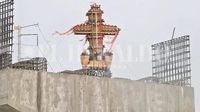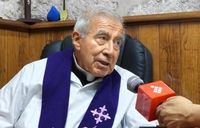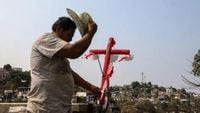On May 3, 2025, Mexico celebrates the Day of the Holy Cross, a significant occasion that intertwines religious, cultural, and labor traditions, particularly among construction workers. This day is marked by the placement of decorated crosses at the highest points of construction sites, symbolizing divine protection and honoring the hard work of bricklayers.
The origin of this tradition dates back to the discovery of the True Cross by Empress Helena around the year 326 AD. According to the Instituto Nacional de los Pueblos Indígenas (INPI), the celebration commemorates this historical event, which is deeply rooted in Christian faith. Although the liturgical calendar recognizes the Exaltation of the Holy Cross on September 14, many Latin American countries, especially Mexico, continue to celebrate the Day of the Holy Cross on May 3 due to popular tradition.
In Mexico, bricklayers have a unique connection to this day. Since colonial times, they have placed crosses atop buildings as a form of seeking divine protection over their work. This practice not only has religious significance but also serves as a tribute to the essential role construction workers play in society, a role that is often overlooked.
The crosses used in this celebration are typically made of wood and adorned with colorful decorations. Common embellishments include colored paper, which symbolizes joy; flowers like roses or carnations, representing life and devotion; and ribbons in various colors, such as white for purity, red for the passion of Christ, and green for hope. In some instances, religious images, candles, or rosaries are added, and the cross may even feature the name of the construction project or a commemorative plaque.
The placement of the cross is often accompanied by a blessing, which can be formal, involving a mass led by a priest, or a simpler, symbolic blessing performed by the workers themselves. When a priest is present, he sprinkles holy water on the cross and the attendees while prayers and hymns are recited. If a priest is unavailable, workers may conduct a brief prayer using holy water brought from a church. This act is performed with solemnity, highlighting its deep significance for those involved in the construction.
Beyond the religious aspects, the Day of the Holy Cross also serves as a moment to strengthen the bonds between workers and their employers. Many construction sites organize meals or gatherings to celebrate the occasion, where bricklayers, architects, and engineers come together in a spirit of camaraderie and gratitude. In some regions, this celebration features music, such as mariachi bands, turning it into a true festive occasion that celebrates the pride of the bricklaying profession.
This tradition also reflects a rich cultural syncretism, blending elements of Catholicism with pre-Hispanic practices. For instance, in certain areas, workers seek permission from the earth before commencing a project, a custom that demonstrates respect for nature and ancestral beliefs. This syncretism enriches the meaning of the Day of the Holy Cross, showcasing how traditions evolve and adapt over time.
In Mexico, the Day of the Holy Cross is not just a religious observance; it is a celebration of community, respect, and recognition. The cross symbolizes faith, identity, and pride for construction workers who view this gesture as a way to honor their labor and seek safety in their work. It is a day that transcends the spiritual realm to become a communal event that fosters unity and appreciation.
The INPI notes that the celebration of the Holy Cross is particularly prominent in regions like Tochimilco, where a cross has been venerated since 1800; Huaquechula, Puebla, where a pilgrimage is made to a stone cross from the 16th century; Angangueo, Michoacán, known for its colorful sawdust carpets and fireworks; and Chilapa, Guerrero, where animal sacrifices are made at the tops of hills.
The Day of the Holy Cross also coincides with the onset of the rainy season, adding an agricultural significance to the celebration. In agricultural communities, the cross is seen as a symbol of Christ Jesus, the giver of life, water, and good harvests. Thus, the festivities are interwoven with themes of fertility, life, and community reproduction.
As the celebration unfolds, the Day of the Holy Cross in Mexico encapsulates a rich tapestry of history, faith, and labor. It is a day where the sacred and the secular blend seamlessly, allowing workers to express their devotion while celebrating their contributions to society. The cross, adorned with flowers and ribbons, stands not only as a religious emblem but also as a testament to the hard work and dedication of those who build the structures that shape our communities.
In conclusion, the Day of the Holy Cross is a vibrant celebration that honors both spiritual beliefs and the essential labor of construction workers. It reflects a unique cultural heritage that continues to thrive, reminding us of the importance of faith, community, and the often-unseen efforts that build our world.



